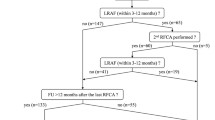Abstract
Background
Recurrent atrial fibrillation (AF) occurs in up to 50 % of patients within 1 year after catheter ablation, and a clinical risk score to predict recurrence remains a critical unmet need. The aim of this study was to (1) develop a simple score for the prediction of rhythm outcome following catheter ablation; (2) compare it with the CHADS2 and CHA2DS2-VASc scores, and (3) validate it in an external cohort.
Methods
Rhythm outcome between 3 and 12 months after AF catheter ablation were documented. The APPLE score [one point for age >65 years, persistent AF, impaired eGFR (<60 ml/min/1.73 m2), LA diameter ≥43 mm, EF < 50 %] was associated with AF recurrence and was validated in an external cohort in 261 patients with comparable ablation and follow-up.
Results
In 1145 patients (60 ± 10 years, 65 % male, 62 % paroxysmal AF) the APPLE score showed better prediction of AF recurrences (AUC 0.634, 95 % CI 0.600–0.668, p < 0.001) than CHADS2 (AUC 0.538) and CHA2DS2-VASc (AUC 0.542). Compared to patients with an APPLE score of 0, the odds ratio for AF recurrences was 1.73, 2.79 and 4.70 for APPLE scores 1, 2, or ≥3, respectively (all p < 0.05). In the external validation cohort, the APPLE score showed similar results (AUC 0.624, 95 % CI 0.562–0.687, p < 0.001).
Conclusions
The novel APPLE score is superior to the CHADS2 and CHA2DS2-VASc scores for prediction of rhythm outcome after catheter ablation. It holds promise as a useful tool to identify patients with low, intermediate, and high risk for AF recurrence.


Similar content being viewed by others
References
D’Ascenzo F, Corleto A, Biondi-Zoccai G et al (2013) Which are the most reliable predictors of recurrence of atrial fibrillation after transcatheter ablation? A meta-analysis. Int J Cardiol 167:1984–1989
Canpolat U, Aytemir K, Yorgun H et al (2013) A proposal for a new scoring system in the prediction of catheter ablation outcomes: promising results from the Turkish Cryoablation Registry. Int J Cardiol 169(3):201–206
Wojcik M, Berkowitsch A, Greiss H et al (2013) Repeated catheter ablation of atrial fibrillation: how to predict outcome? Circ J 77:2271–2279
Kornej J, Hindricks G, Kosiuk J et al (2014) Comparison of CHADS2, R2CHADS2 and CHA2DS2-VASc scores for prediction of rhythm outcomes after catheter ablation of atrial fibrillation: the Leipzig Heart Center AF Ablation Registry. Circ Arrhythm Electrophysiol 7:281–287
Camm AJ, Lip GY, De Caterina R et al (2012) 2012 focused update of the ESC Guidelines for the management of atrial fibrillation: an update of the 2010 ESC Guidelines for the management of atrial fibrillation. Developed with the special contribution of the European Heart Rhythm Association. Eur Heart J 33:2719–2747
Levey AS, Stevens LA, Schmid CH et al (2009) A new equation to estimate glomerular filtration rate. Ann Intern Med 150:604–612
Kornej J, Kosiuk J, Hindricks G, et al (2015) Sex-related predictors for thromboembolic events after catheter ablation of atrial fibrillation: the Leipzig Heart Center AF Ablation Registry. Clin Res Cardiol [Epub ahead of print]
Lip GY, Nieuwlaat R, Pisters R et al (2010) Refining clinical risk stratification for predicting stroke and thromboembolism in atrial fibrillation using a novel risk factor-based approach: the euro heart survey on atrial fibrillation. Chest 137:263–272
DeLong ER, DeLong DM, Clarke-Pearson DL (1988) Comparing the areas under two or more correlated receiver operating characteristic curves: a nonparametric approach. Biometrics 44:837–845
Robin X, Turck N, Hainard A et al (2011) pROC: an open-source package for R and S+ to analyze and compare ROC curves. BMC Bioinformatics 12:77
Tang RB, Dong JZ, Long DY et al (2012) Efficacy of catheter ablation of atrial fibrillation beyond HATCH score. Chin Med J (Engl) 125:3425–3429
Chao TF, Tsao HM, Lin YJ et al (2012) Clinical outcome of catheter ablation in patients with nonparoxysmal atrial fibrillation: results of 3-year follow-up. Circ Arrhythm Electrophysiol 5:514–520
Letsas KP, Efremidis M, Giannopoulos G et al (2013) CHADS2 and CHA2DS2-VASc scores as predictors of left atrial ablation outcomes for paroxysmal atrial fibrillation. Europace. doi:10.193/europace/eut210 Epub ahead of print
National Kidney Foundation (2002) K/DOQI clinical practice guidelines for chronic kidney disease: evaluation, classification, and stratification. Am J Kidney Dis 39:S1–S266
Alberti KG, Zimmet P, Shaw J (2005) The metabolic syndrome—a new worldwide definition. Lancet 366:1059–1062
Grundy SM, Cleeman JI, Daniels SR et al (2005) Diagnosis and management of the metabolic syndrome: an American Heart Association/National Heart, Lung, and Blood Institute Scientific Statement. Circulation 112:2735–2752
Acknowledgments
Dr. Kornej was supported by the German Cardiac Society St. Jude Medical Stipend. Dr. Husser was supported by the Volkswagen Foundation (#84 901). At Vanderbilt this work was supported by Grants from the American Heart Association to Dr. Shoemaker (11CRP7420009), Dr. Darbar (EIA 0940116N), and Grants from the NIH to Dr. Darbar (HL092217). This project was also supported by a Clinical and Translational Science Award (UL1TR000445) from the National Center for Advancing Translational Sciences. Its contents are solely the responsibility of the authors and do not necessarily represent official views of the National Center for Advancing Translational Sciences or the NIH.
Conflict of interest
There are no conflicts of interest.
Author information
Authors and Affiliations
Corresponding author
Rights and permissions
About this article
Cite this article
Kornej, J., Hindricks, G., Shoemaker, M.B. et al. The APPLE score: a novel and simple score for the prediction of rhythm outcomes after catheter ablation of atrial fibrillation. Clin Res Cardiol 104, 871–876 (2015). https://doi.org/10.1007/s00392-015-0856-x
Received:
Accepted:
Published:
Issue Date:
DOI: https://doi.org/10.1007/s00392-015-0856-x




